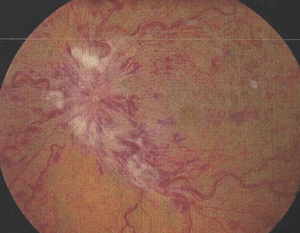Central retinal vein occlusion
Background
- Risk Factors
- Diabetes mellitus
- Hypertension
- Hypercoagulable states
- Vasculitis
- Glaucoma

CRVO Blood and Thunder
Clinical Features
- Loss of vision
- Variable, ranging from vague blurring to rapid, painless monocular vision loss
- Fundoscopy
- Optic disc edema, dilated and tortuous veins, diffuse retinal hemorrhages ("blood-and-thunder fundus")
Differential Diagnosis
Acute Vision Loss (Noninflamed)
- Arteritic anterior ischemic optic neuropathy
- Amaurosis fugax
- Central retinal artery occlusion (CRAO)†
- Central retinal vein occlusion (CRVO)†
- High altitude retinopathy
- Open-angle glaucoma
- Optic neuritis
- Posterior Reversible Encephalopathy Syndrome (PRES)
- Retinal detachment†
- Temporal arteritis†
- Traumatic optic neuropathy
- Vitreous hemorrhage
- Stroke†
†Emergent Diagnosis
Evaluation
Management
- Consult ophtho and neuro
- No treatment regimen provides significant and consistent results
- Complex treatment possibly involving aspirin, anticoagulation, fibrinolysis, lowering IOP, topical steroids, cyclocryotherapy, photocoagulation, intravitreal injections (triamcinolone, anti-VEGF, aflibercept) while managing underlying medical diseases
- Possible benefit from LMWH plus aspirin in central retinal vein occlusion[1]
- May provide a 78% risk reduction of adverse ocular outcome in central vein occlusion
- Less benefit in branched retinal vein occlusion
Disposition
See Also
References
- Lazo-Langner A et al. Low molecular weight heparin for the treatment of retinal vein occlusion: a systematic review and meta-analysis of randomized trials. Haematologica. 2010 Sep; 95(9): 1587–1593.
This article is issued from
Wikem.
The text is licensed under Creative
Commons - Attribution - Sharealike.
Additional terms may apply for the media files.